The 2nd day of God’s work
The two waters and the two heavens
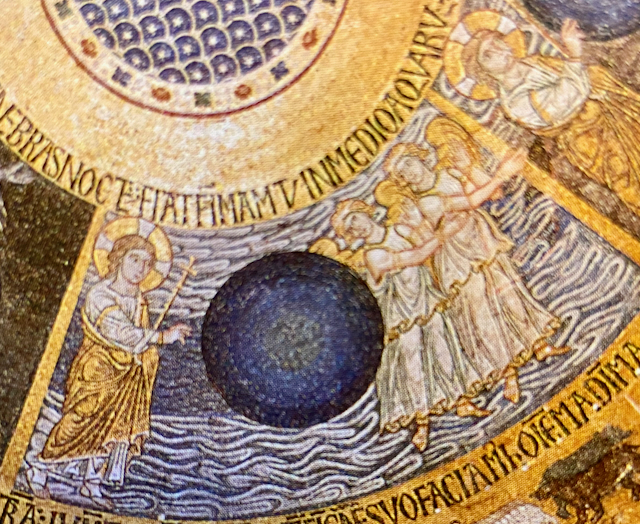
Day 2, Genesis dome. Basilica of San Marco, Venice (13th century). A space separates the waters above from the waters below: it’s the inner sky of our spiritual reality, which directs our spirit towards the source of life that descends from above, from the spiritual sky of the divine and angelic presence.
The second step in God’s work of leading us from darkness to light is to create a link with life, not only the life that animates our bodies, but also the spiritual life. This is why the Hebrew text of the work of God speaks of two waters: one above the sky and one below, on the earth. All the language of the Bible provides us with images to better grasp the spiritual reality we cannot see at first glance. Thus, when we speak of the earth, the word Adamah is close to the word Adam, which designates the human being. This earth therefore needs water, to be connected to a source of life, both bodily and spiritual. So we’re talking about two waters, one of which comes from above, from heaven. This water represents the bond that is created between God and his creature, a bond to which the hope of unconditional love gives us access. If, in the first place, on the first day, human beings can believe in love, in the gesture of love that gives life to the world, then they can connect with the source from which they can draw all happiness and peace. The light of the first day helps us discover the source of all happiness in the loving relationship that links us to God and to our neighbor. The waters of the second day represent this bond, which becomes alive through the love of the neighbor, nourished by the link with the same source of life from which we all draw. An inner sky, a space is created in our lives, the life of the spirit will be what connects human beings. Love is the source of true life, it comes from above, like the waters that descend to earth and which we can finally welcome in trust. In the same way, the Bible text speaks of two heavens, the one we see with our eyes and the one that lights up within us, the heaven where our spirit, our love, unites us to one another. (For a more in-depth analysis of the biblical text, see the second day in the article Genesis 1:1 – 2:3 The seven days, stages of love).
The stages in the life of Jesus
Epiphany, Baptism of Christ
In the ancient tradition, still in force today in the Orthodox Church, three events in the life of Christ were celebrated at the same time: Epiphany, the Baptism of Christ and the miracle of the wedding feast at Cana. This was to show us that, while Christ’s divinity had not yet been revealed to all, he wanted to be close to :
1. other peoples, cultures and religions, represented here by the wise men from the East and the humble shepherds (at the Epiphany).
2. human beings who recognized themselves as sinners and went to John the Baptist to ask for God’s forgiveness (during Christ’s Baptism).
3. the whole of humanity, calling on every human being to enter into a loving relationship with God (Cana).
We’ll look at the first two episodes below, leaving the wedding at Cana to the time when the wedding between God and humanity is consummated, realized, at the crucifixion. (See the wedding at Cana in the Wedding article).
Epiphany
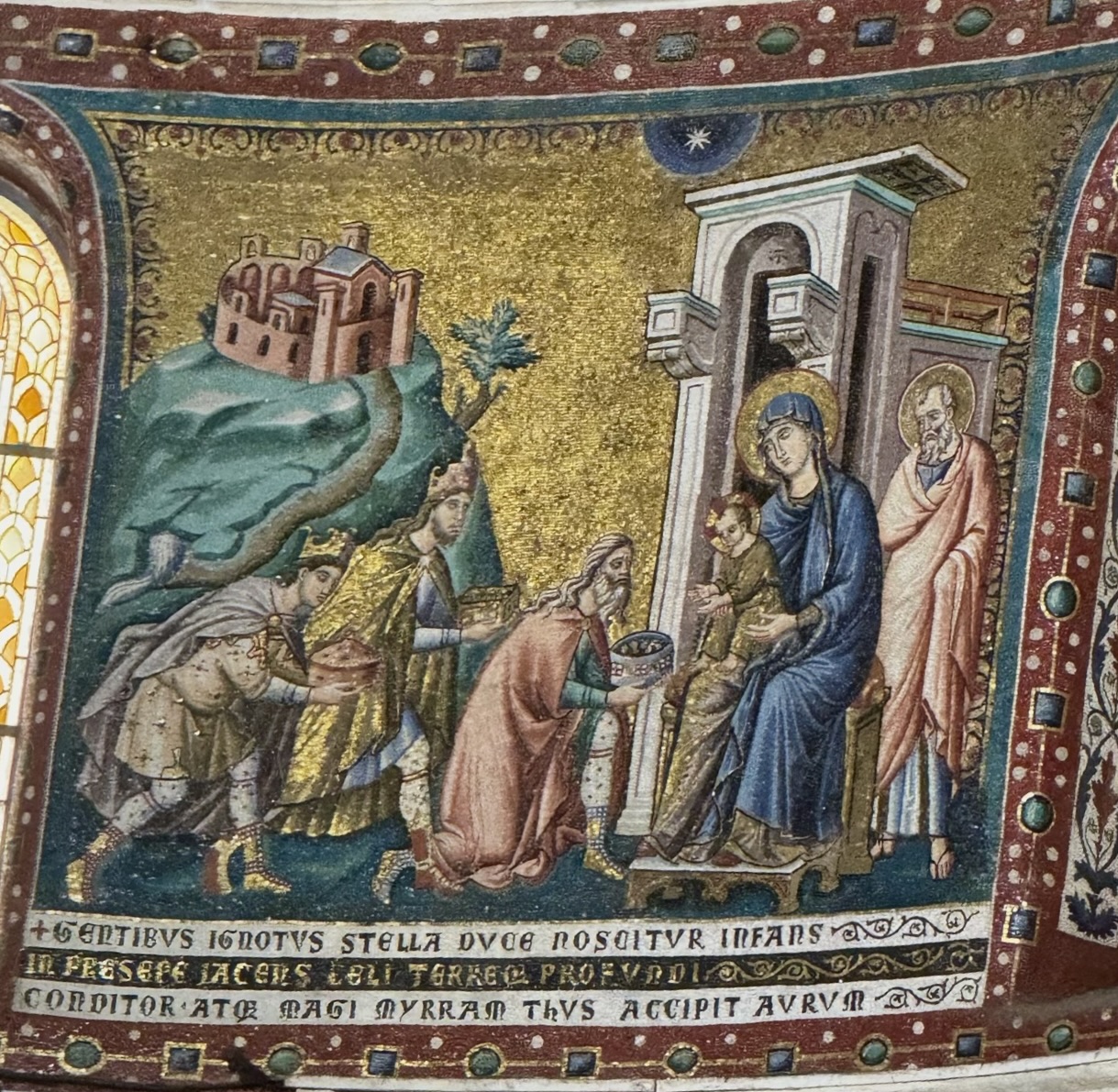
Adoration of the wise men from the East. Mosaic by Pietro Cavallini in the church of Santa-Maria-in-Transtevere (13th century). Jesus welcomes and blesses the gifts of the wise men from the East, announcing that he has come to gather men and women of every language, people, nation and religion. The wise men bring gifts that herald the work Christ will accomplish in this world: 1. gold, the gift offered to the king, for he will be victorious over evil and establish his reign in our hearts. 2. Incense is the offering made to God, for in Jesus is the manifestation of the divine presence (meaning of the word epiphany). 3. Myrrh, perfume to honor the body of the deceased, for it is through his death that Jesus will reveal divine love to the world.
“Jesus was born in Bethlehem in Judea, in the time of King Herod the Great. Now, behold, wise men from the East came to Jerusalem and asked, “Where is the newborn King of the Jews? We have seen his star in the east and have come to bow down before him.” On hearing this, King Herod was distraught, and all Jerusalem with him. He called together all the chief priests and scribes of the people, and asked them where Christ was to be born. They answered him: “In Bethlehem in Judea, for this is what the prophet has written: ‘And you, Bethlehem, land of Judah, are certainly not the last of the chief towns of Judah, for from you a ruler will come forth, who will be the shepherd of my people Israel. Then Herod summoned the wise men in secret to tell them when the star had appeared, and sent them to Bethlehem, saying: “Go and find out all you can about the child. And when you have found him, come and announce it to me, so that I too may bow down before him.” After hearing the king’s words, they set off. And behold, the star they had seen in the east went before them, until it came to rest over the place where the child was. When they saw the star, they rejoiced with great joy. They entered the house, saw the child with Mary his mother, and falling at his feet, they bowed down before him. They opened their treasures and offered him their gifts: gold, incense and myrrh. But, warned in a dream not to return to Herod’s house, they went back to their country by another route. ” (Matthew 2, 1-12)
In search of light and truth, wise men come from the East, ready to recognize the presence of God, not in power, but in a humble child. This child can welcome people of any language, people, nation or creed, without making any difference. He will thus be victorious over the evil that divides men, as signified by the royal gift of gold offered by the wise men, but his kingdom is a spiritual one, and it is in the heart of each person that this victory is exercised. It is the manifestation of God’s gaze on each of his creatures, full of mercy, and it is through the gift of incense that his divinity is signified. How will the glory of God’s presence be revealed to humanity, when it is as if hidden in this little child? It will be when Jesus is ready to give proof of his love even for his enemies on the cross. He will be ready to accept death for the love of mankind, and his death is announced by the gift of myrrh, a perfumed ointment to honour the body of the deceased, in this case to honour the body of Christ who suffered the passion for us. Twice again, the Gospel speaks of a precious balm being offered to him: during Holy Week, sensing his imminent death, Mary, sister of Lazarus, pours a precious balm on Jesus’ feet, and on the morning of the Resurrection, the holy women disciples of Jesus went to the tomb with the balm to honour his body. The Latin inscription below the image recalls this triple gift:
Gentibus ignotus stella duce noscitur infans in presepe iacens celi terreque profundi conditor atque magi myrram thus accipit aurum. “Unknown to the peoples, thanks to the guiding star, becomes known the child lying in the manger, creator of the depths of heaven and earth and from the magi he receives myrrh frankincense and gold.”
Christ’s baptism
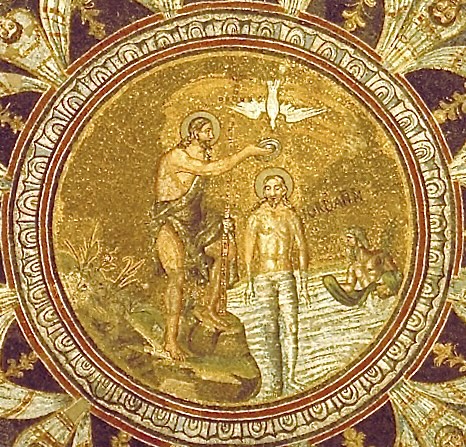
The Baptism of Christ, Orthodox Baptistery, Ravenna, (5th century). John the Baptist pours water from the Jordan over Jesus. Jesus humbled himself by joining the crowd who was asking forgiveness for their sins. But the Bible often reminds us that he who humbles himself will be exalted, so when Jesus is baptized a voice is heard from heaven saying: “This is my beloved Son, in whom I am well pleased.” (Matthew 3:17). And God’s Holy Spirit came upon him in the form of a dove, the image of divine love.
“Then John the Baptist, appeared in the desert. He proclaimed a baptism of conversion for the forgiveness of sins. All Judea and Jerusalem came to him, and were baptized by him in the Jordan, publicly acknowledging their sins. John was dressed in camel’s hair, with a leather belt around his loins; he ate locusts and wild honey. He proclaimed: “Behold, he who is stronger than I is coming after me; I am not worthy to stoop down and undo the strap of his sandals. I baptized you with water; he will baptize you with the Holy Spirit.” In those days, Jesus came from Nazareth in Galilee, and was baptized by John in the Jordan. And immediately, as he came up out of the water, he saw the heavens torn open and the Spirit descending on him like a dove. And there was a voice from heaven: ‘You are my beloved Son; in you I am well pleased.'” (Mark 1, 4-11)
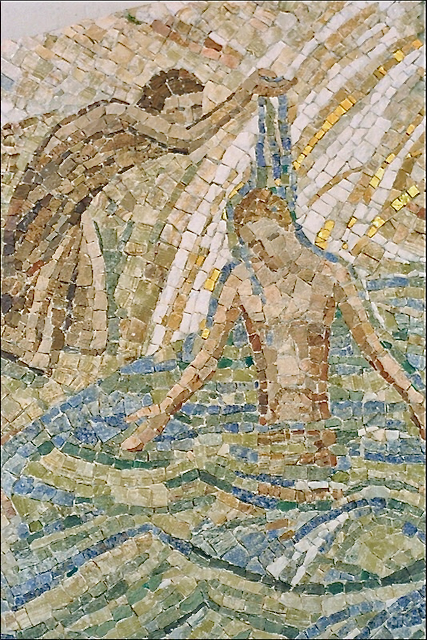
The baptism of Christ. Mosaic from the Basilica of Saint-Maurice, by Madeline Diener, Switzerland.
Just like the prophets of the Old Testament, Christ also announced what he was going to accomplish with a gesture representing God’s work to save humanity and lead it from darkness to light. Jesus, who is the Son of God, the one through whom the world was made, by taking on our human condition, accepts to be confused with sinners. He mingles with the crowd of people on their way to ask God, through John the Baptist, for forgiveness of their sins. And so he descended to the Jordan, whose name comes from the verb “to go down” and which is, in fact, below sea level. This reminds us of the water below, the water that flows over the earth, mentioned on the second day of creation. (See article Genesis 1:1 – 2:3 The seven days, stages of love). This water is an image of human spirit that must be vivified by a relationship with the source of divine life. Jesus will plunge into this humanity, accepting to be confused with any sinner. He will risk his life for us, because he will keep hidden the splendor and glory of his divinity, in order to prove to us to the end the authenticity and gratuitousness of his love for us. Plunging into the water means that he is willing to die for us. To be submerged by water becomes an image of evil that is defeated, that dies, swallowed up by the water, but also, by the fact of rising up, resurfacing from the water, is figured the victory over evil and death. Here the water represents human spirit and the ground represents human being. The water of the river Jordan receives Jesus who is willing to plunge into our humanity, accepting it, even if this will lead him to death. The Spirit of Jesus, the love of God visits us, like water from above, the water which fertilize the earth, to bring it back to life. The water that descends from heaven is the image of God’s spirit that gives us life. The earth, adamah, also represents the human being, which is called Adam in hebrew. When we receive water in the rite of baptism, we are like the dried ground of adamah which receives life from the water above. That means entering into a filial relationship with God, discovering a trusting relationship with the one who gives us life, who fills us with his love. We also see many ancient images of Christ’s baptism, representing the water rising up to Christ, to welcome him, to receive his grace, humanity welcoming its Saviour. And the fish in the water represent people who have found life through faith, through baptism. As the early Christians used to say: “We are the little fish that follow the great fish, Christ. In the water we have found life, and in the water we dwell to keep it.” Indeed, Christ said to his apostles: “Come follow me, and I will make you fishers of men”. (Matthew 4:19) and also, “The kingdom of heaven is like a net that is cast into the sea, and brings back all kinds of fish.” (Matthew 13:47).
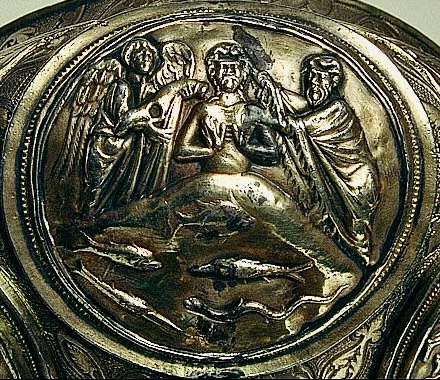
The Baptism of Christ, reliquary bowl, Saint-Maurice Abbey, Switzerland (13th century). The waters rise up to Jesus to be blessed by him, an image of humanity rediscovering the bond of filial love with God, the source of life. In Christian tradition, the fish represent those who have found life in the water of baptism, following Christ.
The apostle Saint Paul sums up the work of Christ, who came to join humanity, taking all the risks, like a shepherd who comes to save the lost sheep and finds it near an escarpment. He plunged into our humanity, assuming it to the point of death, in order to reveal his love for us: “Christ Jesus, having the condition of God, did not jealously retain the rank that made him equal to God. But he emptied himself, taking on the condition of a servant, becoming like men. Recognized as a man by his appearance, he humbled himself, becoming obedient to the point of death, and the death of the cross. This is why God exalted him: he endowed him with the Name that is above every name, so that at the name of Jesus every knee should bow in heaven and on earth and in hell, and every tongue proclaim, ‘Jesus Christ is Lord,’ to the glory of God the Father.” (Philippians 2:6-11).
And also, speaking of baptism, St. Paul tells us: “In baptism you were buried with him and raised with him through faith in the power of God, who raised him from the dead. You were dead because you had committed sins and had not received circumcision in your flesh. But God has given you life with Christ: he has forgiven us all our trespasses.” (Colossians 2:12-13).
Holy Week
Jesus overturns the tables of the Temple merchants
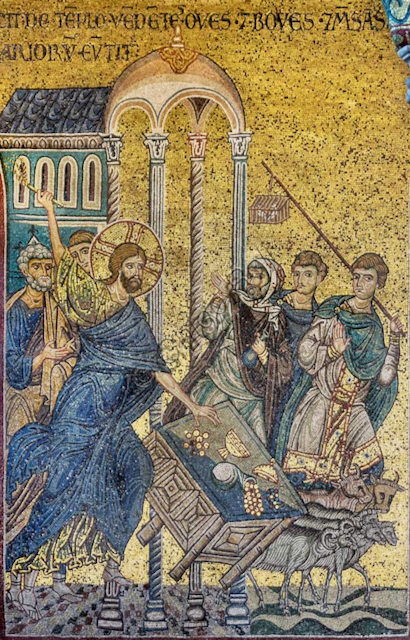
Jesus overturns the tables of the Temple merchants. Mosaic from the Duomo of Monreale, Italy (12th century). Jesus wants to introduce us to the filial relationship with God, to the gratuity of this relationship, a pure exchange of love. He wants to overturn our mercantile mentality, which thinks it can win another’s friendship only by paying him, by buying his favor. As the father says to the son: “Don’t you know that everything that’s mine is yours? So Jesus invites us to go to God in all humility, with our weaknesses and our mistakes, so that he can show us his mercy, the gratuitousness of his love, which doesn’t look at our merits.
All the evangelists report that, after entering Jerusalem to celebrate Passover, Jesus went to the Temple to overturn the merchants’ tables. Here is St John’s account: “As the Passover was drawing near, Jesus went up to Jerusalem. In the Temple, he found the merchants of oxen, sheep and doves, and the money-changers. He made a whip of cords and drove them all out of the Temple, along with the sheep and oxen; he threw the money-changers’ coins to the ground, overturned their counters, and said to the dove-dealers, “Take this away from here. Stop making my Father’s house a house of commerce.” His disciples remembered that it is written: The love of your house will be my torment. Some of the Jews asked him, “What sign can you give us for doing this?” Jesus replied, “Destroy this temple, and in three days I’ll raise it up.” The Jews replied, “It took forty-six years to build this temple, and you would raise it up in three days!” But he was talking about the temple of his body. So when he rose from the dead, his disciples remembered that he had said this, and they believed the Scripture and the word Jesus had spoken. While he was in Jerusalem for the Passover feast, many believed in his name, seeing the signs he performed.” (John 2:13-23).
This gesture is of great importance, and the evangelists Matthew, Mark and Luke specify that Jesus performed it as soon as he entered Jerusalem, during Holy Week. What Jesus did during the Holy Week, the last week of his life, sums up his entire life’s work. It’s as if he were making visible what God accomplished in his work, according to the Genesis account, which describes the various stages through which God leads mankind from darkness to light. (See article Genesis 1:1 – 2:3 The seven days, stages of love). Here we are at the second stage, which shows us the water from below, which is on earth, and the water from above, which descends from heaven. This is the water of our humanity, the water of our spirit, which comes back to life when it rediscovers its trusting, filial relationship with God. Humanity thus discovers the source of life in God’s loving gesture of offering us his own life, just as Jesus on the cross makes this act of God’s love visible to us by giving his life for us. The point here is to rediscover the faith that enables us to have a trusting relationship with God. According to the Genesis account, human beings have broken their trusting relationship with God. Instead of seeing God as the one who gives us everything, who gives us life, i.e. his own spirit, his own breath, to make us in his image and likeness, human beings dare not believe in the gratuitousness of such love. Humanity is a prisoner of the commercial relationship: I give to you in order to receive. We dare not believe in gratuitous love: if someone gives something, it is to receive something in return. But God is love and gratuitous love (it’s the word charity, in Greek χάρις, kháris grace, that expresses this gratuitous love). When we give because we rejoice in the happiness of others, we give grace, that is, we share our own happiness, our own joy, so that we can welcome it in others, and so our own joy is multiplied. This is God’s creative gesture, his desire that his own joy be experienced by others, and by seeing us happy, his own joy is multiplied. It’s the joy of the parents in the child’s smile: all the trouble they’ve gone trhough for him is rewarded, they’re happy in his happiness, their joy is at its height. Our true and greatest joy comes from contemplating the happiness of others, of our fellow man. What the beginning of the book of Genesis tells us (see the article Genesis 1:23 – The Fault) is that a doubt, a suspicion, represented by the snake, has crept into the human mind: “God doesn’t want us to be like him, he doesn’t give us access to his happiness”, so the snake encourages Eve, who figures all humanity, to disobey: “God knows that on the day you eat of it, your eyes will be opened, and you will be like gods, knowing good and evil.” (Genesis 3:5). To think that God hides his happiness from us, that he doesn’t want us to be like him, is the exact opposite of what God wanted when he gave us life, when he gave us his own life: that we should be his image, perfectly resembling him, that is, what we should experience: perfect love, the greatest joy, because God is love, and he tells us, in Jesus’ own words: “As the Father has loved me, so I have loved you. Abide in my love. If you keep my commandments, you will abide in my love, just as I have kept my Father’s commandments and abide in his love. I have told you this so that my joy may be in you, and that your joy may be complete. My commandment is this: Love one another as I have loved you. Greater love has no one than this, that he lays down his life for those he loves. (John 15:9-13). God is love, and we abide in him by tasting the greatest joy through the greatest love we can offer to our neighbor, the gift of our own life. This will make us fully happy, and the life passed on to our neighbor will spring up in us as a fountain, a source of joy. It should also be noted that the word commandment does not translate the vocabulary used in the Bible. In the Gospels, Jesus uses the word entolē (ἐντολή), which contains the word télos (τέλος), the goal, perfection, indicating what leads us to perfection, to wholeness.
Thus, in the Temple we see the relationship that mankind has with God: a commercial relationship, not one of trusting, filial love. Since humanity doubts God’s benevolence, his gratuitous love, it needs to buy this love from him to guarantee his benevolence, his favor. Depending on the goods at their disposal, some will offer a dove, a lamb, even an ox, thus obliging God to return the favor, as if God needed our goods, as if He had given us life in order to receive something in return, to be paid. The presence of the merchants in the Temple thus attests to the error of humanity, which has cut itself off from a trusting relationship with God, and dares not believe in the gratuitousness of his love. Yet the prophets had often repeated, and Isaiah affirms it immediately, at the very beginning of his book: “What do I care for the number of your sacrifices? – says the Lord. The burnt offerings of rams and the fat of calves, I have enough of it. I take no pleasure in the blood of bulls, lambs or goats. When you come to present yourselves before my face, who asks you to tread on my courts? Stop bringing vain offerings; I abhor your incense. New moons, sabbaths, assemblies – I can’t stand these crimes and festivals any longer. I hate your new moons and your solemnities: they’re a burden for me, and I’m tired of carrying it. When you stretch out your hands, I avert my eyes. No matter how many times you pray, I don’t listen: your hands are full of blood. Wash yourselves, purify yourselves, remove your evil deeds from my sight, stop doing evil. Learn to do good: seek the right, bring the oppressor to heel, give justice to the orphan, defend the widow’s cause. Come and let’s talk – says the Lord. If your sins are like scarlet, they will become as white as snow. If they are red like vermilion, they will become like wool.” (Isaiah 1:11-18)
And likewise in the prayer of the Psalms: “If I offer a sacrifice, you will not accept it; you will not accept a burnt offering. The sacrifice that pleases God is a broken spirit; you do not repulse, O my God, a broken and crushed heart.” (Psalm 50:18-19)
So, when Jesus overturns the tables of the merchants, he shows us that he has come to overturn this merchant mentality. When we want to enter into a relationship with God, it’s not to buy his benevolence, so we offend him and cut ourselves off from life, from filial relationship. Jesus invites us to rediscover the true nature of God, the very origin of the life we have received as a gift of love. So, if we have offended him, despised him, if we have suspected him, he invites us to find him, to ask his forgiveness, to return to him. Even if we have turned against him, even if we have offended him, he will have mercy on us, he will welcome us with joy. Jesus tells us that the true Temple where we are in relationship with God, the place of our union with him, is within us. Just as his own body is the Temple of God, for us too, the place where we live out our filial bond of love and trust with God is within us. So Jesus invites us to rediscover him, to trust in the gratuity of his forgiveness, in the infinitely repeated gift of his life, because for-giving means giving, again and again (see also the article The gratuity of love). “I tell you: there is more here than the Temple. If you had understood what it means: I want mercy, not sacrifice, you would not have condemned those who have done nothing wrong. For the Son of Man is Lord of the Sabbath.” (Matthew 12:6-8). And also: “Go and learn what it means: I want mercy, not sacrifice. For I have not come to call the righteous, but sinners.” (Matthew 9:13). So, those who recognize themselves as sinners will find mercy, will be welcomed back and celebrated, as Jesus tells us in the parable of the prodigal son, who, having left his Father, is awaited and welcomed back with great celebration (see the article Luke 15, 11-32 The prodigal son and the articles linked to the theme of God’s gratuitous love cited at the end of that article).
Saint Paul can thus affirm: “Do you not know that you are the Temple of God, and that the Spirit of God dwells in you?” (1 Corinthians 3:16). All we need to do is rediscover our filial trust in God, rediscover the source of our life in God’s gratuitous gesture of love, and this is what baptism signifies: water is the source of life that links us all to one another and makes us all children of the same Father.
The relationship with God and with our neighbor
The source of life
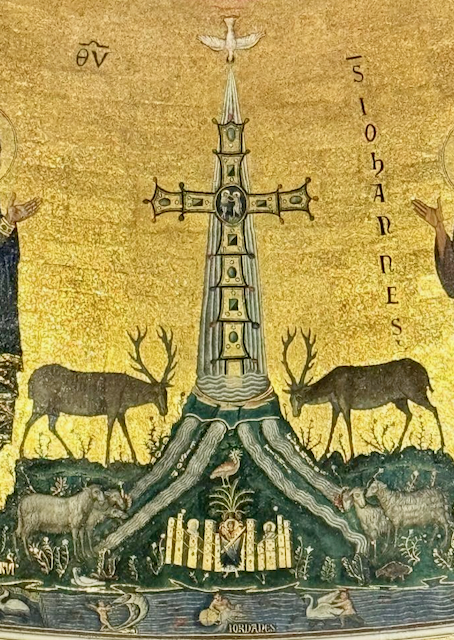
The tree-of-life cross in the Garden of Eden. Basilica of Saint John Lateran, Rome (13th century). Entering the basilica from the adjacent baptistery, the newly baptized were confronted with this image, which sums up their entry into eternal life, into a filial relationship with God, into the terrestrial Paradise. Indeed, in the center of the cross is the image of Christ’s baptism by John, representing his abasement and the gift of his love to humanity. At the top, from the beak of the dove representing the Holy Spirit, flows the river of love which, crossing the cross, will irrigate the earth. It is the water from above that the baptized welcomes, a sign of his relationship with the divine source of life. It’s of this source that the Book of Genesis tells us when it says that a river flowed out of Eden, from Paradise, and divided into four rivers, whose names are written in this mosaic beside each river. Thus, the significance of baptism for Christians is clear: the tree of life prophetically referred to in the Book of Genesis is the cross from which the river of love flows from the side of Christ to irrigate the whole earth. The moment human beings recognize the origin of their life, they enter eternal life. At the bottom of the image, the deer drink from the source: “As a thirsty deer seeks living water, so my soul seeks you, my God”. (Psalm 41:2). At the foot of the cross is the heavenly Jerusalem, whose columns bear the heads of the apostles, for it was their witness that gave access to this source that reconciles all men in the same fraternal love. The entrance to the heavenly Jerusalem is guarded by a seraph who brings the word of God and the gospel to mankind, and above it, the phoenix, the bird that rises from its ashes, representing Christ’s resurrection and the new life offered to the baptized.
This is the image offered to the newly baptized who, leaving the baptistery with their candles lit at the Easter vigil, finally enter the Basilica of St. John Lateran in Rome. This ancient mosaic represents the earthly paradise that Christ is now making accessible to human beings. Indeed, according to the story in the Book of Genesis, mankind’s suspicion of God, separating it from him, broke the trusting filial relationship. Human beings find themselves estranged from God because they are unable to believe in the immensity of His love (for the Genesis account of Eden, see the articles: Genesis 2:4-14 Eden, Genesis 2:15-25 Creation of the Woman and Genesis 3:1-24 The Fault). Thus, the Word of God, which human beings are unable to believe, becomes flesh in Jesus Christ. God’s creative work becomes visible, the gift of his life to humanity becomes concrete in the proof of love that Jesus offers by accepting death and dying on the cross. The assurance of his forgiveness, unconditional to all humanity, opens the way to God. We have seen his merciful face, and we can trust that despite our errors, he will not abandon us; on the contrary, he is ready to risk his life for each and every one of us. Now it’s possible to understand the prophetic Scriptures, the Word of God, now it’s possible to understand the eternal dimension of God’s words. Indeed, the words of the Book of Genesis, which sum up the history of our relationship with God, as God’s words are immutable and therefore valid for the whole history of mankind, for God knows no change and neither does his Word. So these ancient words, which speak of a tree of life in the midst of Paradise, can also be understood referred to the tree of the cross, the dead wood on which Christ offered his life to the world, the wood from which life sprang. Indeed, Genesis 2:10 states that “A river flowed out of Eden to water the garden, and from there it divided and became four heads…”. And the text goes on to give the name of each of the rivers into which the river of life divides to irrigate the world: Gihon, Pishon, Tigris and Euphrates, as it is written next to each of the rivers flowing from the glorious cross, the tree-of-life cross in the mosaic in the apse of St. John Lateran above. Looking closely at the image, we see, in fact, a river that has its origin in the dove that represents the Holy Spirit, the one who in the second verse of Genesis hovered over the waters to infuse them with the divine Spirit (see article Genesis 1, 2 Ruah – The Spirit of God is feminine), the one who vivifies the world and transmits God’s love to it. The Spirit is full of tenderness, like a dove, gathering her young under her wings, she broods over them infusing them with her love, she has eyes of great beauty because she sees the face of God, she recognizes him in Christ and in every human being a son of God, his own son. This is why Christ’s cross, luminous because it is a sign of victory over evil and darkness, is crossed by a river that comes from the dove. This victory over evil and death was achieved through the superabundance of love and mercy, through the forgiveness offered to every human being. Only in this way could a breach be opened in the hardened hearts of mankind. Jesus said it well, echoing the words of the prophet Isaiah: “He who believes in me, as the Scripture has said, rivers of living water will flow from his belly”. (John 7:38). (On the subject of the source of living water, see the article: John 4, 1-42 The source of living water). So the cross is the true tree of life spoken of in Genesis, and we can access it through faith, that is, through the filial trust we can place in God. The human being who can call God Father is animated by the spirit of filial love, the same Holy Spirit who gives life to the world, as Saint Paul says: “Indeed, all who let themselves be led by the Spirit of God are sons of God. You have not received a spirit that makes you slaves and brings you back to fear; but you have received a Spirit that makes you sons; and it is in him that we cry “Abba!”, that is to say: Father! So it is the Holy Spirit himself who testifies to our spirit that we are children of God.” (Romans 8:14-16). This faith is expressed in baptism, when the human being proclaims that the source of life, the source of his life, is in God, and that this life is offered to everyone. He therefore recognizes that he is a brother to a multitude of people of every language and creed, and it is in this sense of brotherhood that he dares to turn to God and call him Our Father. The Our Father prayer that Jesus passed on to the apostles was in fact transmitted to the newly-baptized at baptism, and it is by recognizing himself as a son of God, and by recognizing the rest of humanity as his brothers and sisters, that he can effectively say: “Our Father”.
The link between baptism and the cross is clearly apparent in this mosaic: in the center of the cross, a medallion depicts Jesus being baptized by John the Baptist. It was then that the Holy Spirit, in the guise of a dove, hovered over Jesus, and the voice from heaven declared: “You are my beloved Son; in you I rejoice”. (Luke 3:22). These words are now addressed to every baptized person, and it is possible to enter Paradise right now, by rediscovering the filial relationship that unites us to God, as Jesus invites us to do: “Then Jesus called a little child to himself, and set him in the midst of them, and said, ‘Amen, I say to you, unless you change and become like children, you will not enter the kingdom of heaven. But whoever makes himself small like this child, he is the greatest in the kingdom of heaven. And whoever welcomes a child like this in my name, welcomes me.” (Matthew 18:2-5). The day of baptism is therefore regarded by Christians as the day of entry into Paradise, into eternal life, into the Kingdom of Heaven.” Indeed, eternal life, that is, the presence of God’s love within us, began when we accepted his forgiveness. Filled with gratitude, the human being is filled with love, for he has measured the extent of God’s mercy, and so his love now dwells within him. Nevertheless, we must abide in this love, for “the kingdom of heaven will not be entered by saying to me, ‘Lord, Lord’, but by doing the will of my Father who is in heaven” (Matthew 7:21), that is, by putting this faith into practice, by loving our neighbor as ourselves, for, according to faith, our neighbor is our own brother. In this way, we remain in love, in God’s eternal life. Then the Kingdom of God, the heavenly Jerusalem where we are all one, the city where we are all brothers and sisters, united by the same love, descends into our hearts. Jesus himself tells us: “For behold, the kingdom of God is within you.” (Luke 17:21). This is why, at the foot of the tree of life, we find the image of the heavenly Jerusalem: in the cross, God offers his life to humanity, which regains trust and faith in God, and this faith, expressed in baptism, makes the whole of humanity a people of brothers and sisters. It is this spiritual reality that is called heavenly Jerusalem, and we see it represented at the feet of the cross, its walls gilded, its columns bearing the heads of the apostles who passed on the faith, and its door guarded by a seraph, the angel burning with God’s love. It is only through love that we enter this spiritual reality, when we welcome in every human being a brother or sister. And again, in the middle of the heavenly Jerusalem, in the mosaic, we see a tree, the tree of life, and above this tree a bird, the phoenix, this animal that rises from its ashes, victorious over evil and death.
Phrase of the Lord’s Prayer
Hallowed be thy name
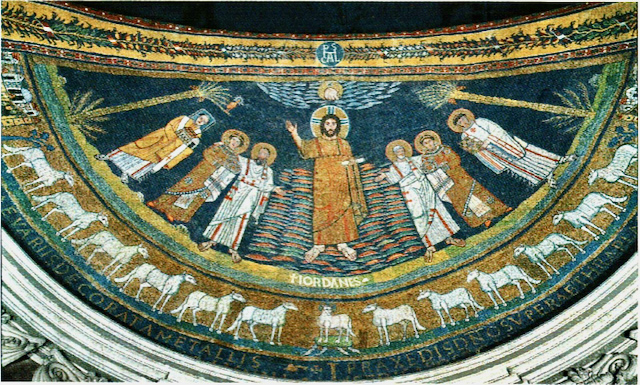
Jesus in the waters of the Jordan. Mosaic from the church of Santa Pudentiana, Rome (4th century). Jesus is the Word of God who reveals his love to the world by plunging into our humanity. In this way, human beings who have rediscovered their trust in God, animated by the same love, will be able to give the same testimony of love to the world, plunging into our humanity to the point of giving their lives. Baptism is a testimony to the gift of one’s life, an expression of the greatest love. Thus, the faithful, those who trust, will be like the sheep, forming a single flock, depicted at the bottom of the mosaic. They will also drink from the waters of the Jordan, whose name is written at the feet of Jesus, and whose name indicates the act of descending, of lowering oneself, to the point of giving one’s life.
The mosaic in the apse of the church dedicated to Saint Praxedes in Rome shows Christ in the waters of the Jordan with the scroll of the Word of God in his hand. It was this Word of God that became flesh in Himself, and He lived the love spoken of in the Bible in His own person, to the point of giving His life. Speaking of baptism, he said to the apostles who wanted to sit on his right and left in heaven: “Can you drink the cup I’m about to drink, be baptized with the baptism I’m about to be immersed in?” They said to him, “We can.” Jesus said to them, “The cup I’m about to drink, you shall drink; and you shall be baptized with the baptism I’m about to be immersed in.” (Mark 10:38-39). When he speaks of the cup, Jesus speaks of the blood he was about to shed, and when he speaks of the baptism he was about to receive, he speaks of his testimony of love for humanity, of his willingness to plunge into our humanity to the point of assuming the risk of death. And he proclaims that the apostles too will bear witness with the gift of their own lives out of love for their neighbor. This is the gift of the Spirit of God, who will fill them with a love similar to that of God: having seen how God loves us, the love they contemplate fills them and makes them a reflection of God’s glory in this world. They have become a temple of the Holy Spirit. And Jesus encourages them in the face of the persecution they, like him, are about to face: “When you are handed over, do not worry about what you will say or how you will say it: whatever you have to say will be given to you at that time. For it is not you who will speak, but the Spirit of your Father who will speak in you.” (Matthew 10:19). In this way, Jesus transmits his word to his apostles, meaning that God’s Spirit of love dwells in them too. Indeed, in many ancient representations, we see Christ transmitting the scroll of God’s word to the apostles, as in this image where Peter and Paul are on Christ’s right and left, reaching out to receive and welcome his word, and at the same time to present to him the holy Pudentian and Praxedes, women who also offered their lives as a testimony of love for their neighbor. Indeed, tradition praises the charitable deeds of these two sisters, who are considered saints. This is how we should understand the words of the Our Father: “Hallowed be thy name.” Indeed, Jesus speaking of the apostles speaks of sanctification: “Sanctify them in the truth: your word is truth. As you sent me into the world, so I have sent them into the world. And for their sake I sanctify myself, so that they too may be sanctified in the truth. I pray not only for those who are here, but also for those who will believe in me through their word. May they all be one, as you, Father, are in me, and I in you. May they also be one in us, so that the world may believe that you sent me.” (John 17, 17-21). If the apostles are holy through their works of charity, they glorify the Father who gave them life, just as parents are proud if their children are praised. In this way, the faithful’s testimony of love reveals the glory of God the Father to the world: seeing how they love one another, the world will see God’s love and give glory to God. The request in the prayer of Our Father therefore means that we wish to sanctify the Father’s name by putting into practice the faith of baptism, by following God’s Spirit of love, by manifesting it to the world. In this way, the face of Christ and his love will be reflected in his disciples, who will also become the light of the world, leading humanity to the source of life, to the love of God and neighbor.